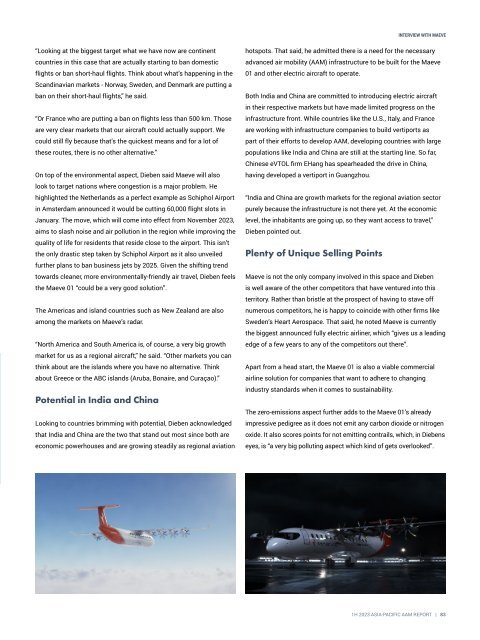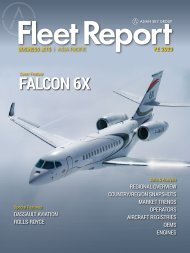Asia-Pacific AAM Report 1H 2023
Create successful ePaper yourself
Turn your PDF publications into a flip-book with our unique Google optimized e-Paper software.
INTERVIEW WITH MAEVE<br />
“Looking at the biggest target what we have now are continent<br />
countries in this case that are actually starting to ban domestic<br />
flights or ban short-haul flights. Think about what’s happening in the<br />
Scandinavian markets - Norway, Sweden, and Denmark are putting a<br />
ban on their short-haul flights,” he said.<br />
“Or France who are putting a ban on flights less than 500 km. Those<br />
are very clear markets that our aircraft could actually support. We<br />
could still fly because that’s the quickest means and for a lot of<br />
these routes, there is no other alternative.”<br />
On top of the environmental aspect, Dieben said Maeve will also<br />
look to target nations where congestion is a major problem. He<br />
highlighted the Netherlands as a perfect example as Schiphol Airport<br />
in Amsterdam announced it would be cutting 60,000 flight slots in<br />
January. The move, which will come into effect from November <strong>2023</strong>,<br />
aims to slash noise and air pollution in the region while improving the<br />
quality of life for residents that reside close to the airport. This isn’t<br />
the only drastic step taken by Schiphol Airport as it also unveiled<br />
further plans to ban business jets by 2025. Given the shifting trend<br />
towards cleaner, more environmentally-friendly air travel, Dieben feels<br />
the Maeve 01 “could be a very good solution”.<br />
The Americas and island countries such as New Zealand are also<br />
among the markets on Maeve’s radar.<br />
“North America and South America is, of course, a very big growth<br />
market for us as a regional aircraft,” he said. “Other markets you can<br />
think about are the islands where you have no alternative. Think<br />
about Greece or the ABC islands (Aruba, Bonaire, and Curaçao).”<br />
Potential in India and China<br />
Looking to countries brimming with potential, Dieben acknowledged<br />
that India and China are the two that stand out most since both are<br />
economic powerhouses and are growing steadily as regional aviation<br />
hotspots. That said, he admitted there is a need for the necessary<br />
advanced air mobility (<strong>AAM</strong>) infrastructure to be built for the Maeve<br />
01 and other electric aircraft to operate.<br />
Both India and China are committed to introducing electric aircraft<br />
in their respective markets but have made limited progress on the<br />
infrastructure front. While countries like the U.S., Italy, and France<br />
are working with infrastructure companies to build vertiports as<br />
part of their efforts to develop <strong>AAM</strong>, developing countries with large<br />
populations like India and China are still at the starting line. So far,<br />
Chinese eVTOL firm EHang has spearheaded the drive in China,<br />
having developed a vertiport in Guangzhou.<br />
“India and China are growth markets for the regional aviation sector<br />
purely because the infrastructure is not there yet. At the economic<br />
level, the inhabitants are going up, so they want access to travel,”<br />
Dieben pointed out.<br />
Plenty of Unique Selling Points<br />
Maeve is not the only company involved in this space and Dieben<br />
is well aware of the other competitors that have ventured into this<br />
territory. Rather than bristle at the prospect of having to stave off<br />
numerous competitors, he is happy to coincide with other firms like<br />
Sweden’s Heart Aerospace. That said, he noted Maeve is currently<br />
the biggest announced fully electric airliner, which “gives us a leading<br />
edge of a few years to any of the competitors out there”.<br />
Apart from a head start, the Maeve 01 is also a viable commercial<br />
airline solution for companies that want to adhere to changing<br />
industry standards when it comes to sustainability.<br />
The zero-emissions aspect further adds to the Maeve 01’s already<br />
impressive pedigree as it does not emit any carbon dioxide or nitrogen<br />
oxide. It also scores points for not emitting contrails, which, in Diebens<br />
eyes, is “a very big polluting aspect which kind of gets overlooked”.<br />
<strong>1H</strong> <strong>2023</strong> ASIA-PACIFIC <strong>AAM</strong> REPORT | 83
















